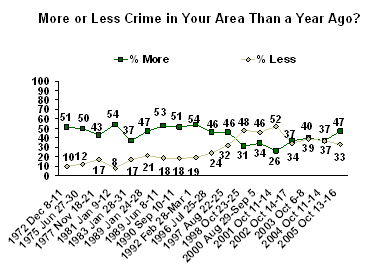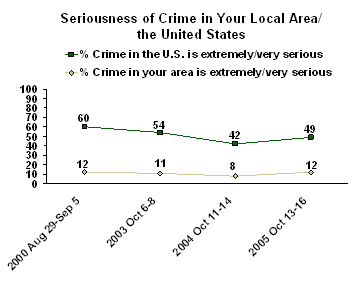GALLUP NEWS SERVICE
PRINCETON, NJ -- Violent crime in the United States, specifically murder, rose in 2005, according to preliminary statistics released by the FBI. The report indicates that crime in the United States increased more rapidly in 2005 than at any other point since the early 1990s, with the number of violent crimes increasing by 2.5% and the number of murders increasing by 4.8%.
Gallup's most recent Crime survey, conducted Oct. 13-16, 2005, foreshadowed these results, indicating that the average American was already seeing signs of increasing crime in their local areas last fall, and that Americans already perceived that the crime rate was going up nationwide. The data show higher concern about crime on a variety of measures than at any point in the last decade. Still, although the number of murders is up across the country, few Americans report an increase in violent crime victimization or that they spend time worrying about being murdered.
Here is a more detailed look at the trends:
- The October 2005 poll finds that 47% of Americans say there is more crime in their local area now than there was a year ago. This marks a 10-point increase from 2004, and is at the highest level that Gallup has recorded since the mid-1990s. The high point since Gallup began asking this question in 1972 is 54%, observed in 1981 and again in 1992.

- Americans' views of the crime rate in the United States is at its highest point since the mid-1990s, with 67% in the 2005 poll saying there is more crime in the country. That's up 14 points from 2004, when just 53% shared this point of view. Views of crime in the country were much higher in the late 1980s and early 1990s, reaching a high point of 89% in 1992.

- Another long-standing trend question asks Americans if there is "any area near where you live -- that is, within a mile -- where you would be afraid to walk alone at night." According to the latest update, 38% of Americans say there is such an area in their neighborhood. This represents a six-point increase from 2004, and is the highest percentage answering this way since 1997. The high point on this measure was 48% in 1982, and the low point was 30% in 2001.

- The 2005 survey also shows an increase from 2004 in Americans' perceptions about the seriousness of crime both in their local area and throughout the country. Twelve percent of Americans say the crime problem in their area is extremely or very serious, up from 8% in 2004. Nearly half of Americans (49%) say the crime problem in the United States is extremely or very serious, up from 42% in 2004. Both measures have been at these levels or higher at various times since 2000.

There are two areas in which Americans' responses to questions on crime show little change in recent years -- reports of violent crime victimization and the fear of being murdered.
Five percent of Americans report that someone in their household was a victim of a violent crime in the last year. Since 2000, this percentage has fluctuated modestly, between 3% and 5%. On a personal level, 3% of Americans say that they themselves were victims of a violent crime in the last year; this percentage has only fluctuated between 2% and 3% since 2000.
Roughly one in six Americans say they frequently (5%) or occasionally (10%) worry about being murdered. Since 2000, at most, only 18% of Americans have expressed this level of concern about being murdered.
Murder ranks near the bottom of the list of crime worries that Gallup asks Americans annually. Only worry about being assaulted or killed by a coworker or employee in the workplace ranks lower than being murdered. Americans tend to express greater concern about more common incidents such as car theft, home burglaries, or having a school-aged child harmed at school.
|
How often do you, yourself, worry about the following things -- frequently, occasionally, rarely, or never? |
||||
|
Frequently |
Occasionally |
Rarely |
DOESN'T |
|
|
% |
% |
% |
% |
|
|
Having your car stolen or broken into |
16 |
26 |
55 |
3 |
|
Your home being burglarized when you are not there |
15 |
30 |
55 |
* |
|
Being the victim of terrorism |
14 |
24 |
62 |
* |
|
Having a school-aged child physically harmed attending school |
14 |
15 |
42 |
29 |
|
Your home being burglarized when you are there |
8 |
16 |
76 |
* |
|
Getting mugged |
7 |
21 |
72 |
* |
|
Being attacked while driving your car |
6 |
16 |
75 |
3 |
|
Being sexually assaulted |
6 |
13 |
81 |
* |
|
Being a victim of a hate crime |
6 |
11 |
82 |
1 |
|
Getting murdered |
5 |
10 |
84 |
* |
|
Being assaulted/killed by a coworker/employee where you work |
2 |
4 |
82 |
12 |
|
(vol.) = Volunteered response |
|
|
|
|
Survey Methods
Results are based on telephone interviews with 1,012 national adults, aged 18 and older, conducted Oct. 13-16, 2005. For results based on the total sample of national adults, one can say with 95% confidence that the margin of sampling error is ±3 percentage points. In addition to sampling error, question wording and practical difficulties in conducting surveys can introduce error or bias into the findings of public opinion polls.